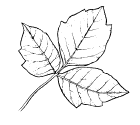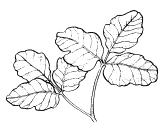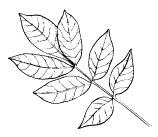The Sleep Tight Video©
Help for sleepless parents
|
Encyclopedia Index
|
| Search |
poison ivy
Poison ivy (Rhus dermatitis) is a "feature" of summer. It isn't hard to diagnose: it's characterized by linear streaks (lines) of extraordinarily itchy (pruritic) vesicles where the plant leaves have brushed against the skin. Contrary to what you might believe, fluid from ruptured skin blisters does not spread the eruption; however, the plant oil which is still present on the skin, under the fingernails, and on clothing can cause new areas of eruption if it isn't removed by washing with soap and water. The plant oil (oleoresin) may also be carried by animals on their fur, so petting or hugging a dog that has been rolling around in the woods can result in the classic poison ivy rash with no obvious history of exposure.
All parts of the plant contain the sap, and the allergen (urushiol) is present on live or dead leaves, which means you must use caution cleaning out old plant material in the fall and winter. Watch out - burning this material can produce smoke with the oil in it, which can cause extensive eruptions. The eruption may appear as quickly as 8 hours after contact or may be delayed for a week or more. That is why poison ivy appears to spread - the areas exposed most intensely erupt first, and the areas just barely touched break out later.
Use cold wet compresses during the acute blistering stage. They are highly effective and should be used for 15 to 30 minutes several times a day for 1 to 3 days until blistering and severe itching is controlled. Topical steroids do not penetrate through blisters.
Short, cool tub baths with or without Aveeno® are very soothing. Calamine lotion controls itching but prolonged use causes excessive drying. Hydroxyzine (Atarax®) and diphenhydramine (Benadryl®) help control itching and encourage sleep.
Hydrocortisone 1% cream, available over the counter as Cort-Aid® or any number of other brands, is helpful to reduce the inflammation and itching. A stronger prescription preparation may be necessary. Prednisone or similar steroids are used orally for severe, widespread inflammation. Alternatively, a steroid injection can be given. Children who initially don't look too bad may get worse over the next few days and parents need to call their child's doctor if the condition worsens dramatically.
Poison ivy and poison oak are of course neither ivy nor oak species. Sensitization to one plant in the Rhus family produces cross-reactions with the other plants in the family - notably poison sumac and poison oak.
There is unfortunately no 100% effective preventative treatment1; simply avoiding exposure is the best advice. Washing the skin with soap inactivates and removes all surface oleoresin; it is most effective if done within 15 minutes of exposure, so if you think you or your child has been exposed, thoroughly scrub with soap and water as soon as possible and change clothes. Use a grease-cutting dishwashing detergent or even better a harsh soap like Fels Naptha. Standard body soap is not effective in removing the resin from the skin, and may even spread it around.
Long protective clothing lessens the odds of a rash, but the oil can penetrate the clothing. Also, contaminated clothing items pose a risk of rash to whoever handles them in the laundry room.
 |
poison ivy |
 |
poison oak |
 |
poison sumac |
1. A few products available in the US over the counter are labeled as preventative. I have not had enough experience with them to be able to give them any endorsement; if your child is severely allergic to the rhus family of plants, you might consider them:
Tecnu Outdoor Skin Cleanser® (Tec Labs) is applied as soon as possible after exposure and rubbed into the affected areas. It is left on at least two minutes, then wiped off (water is not necessary). Potentially a "lifesaver" if you are out hiking and suddenly realize your child is standing right in the middle of a poison ivy patch, and there is no water around.
Stokogard Outdoor Cream® (Stockhausen) is a barrier cream used before possible exposure.
IvyBlock Lotion® is also effective in blocking urushiol dermatitis if it is applied at least 15 minutes prior to exposure. It should be reapplied at least every 4 hours during times of possible exposure.
| Night, Night! Dr. Hull's Common Sense Sleep Solutions© |
|
Site Information/Disclaimer |